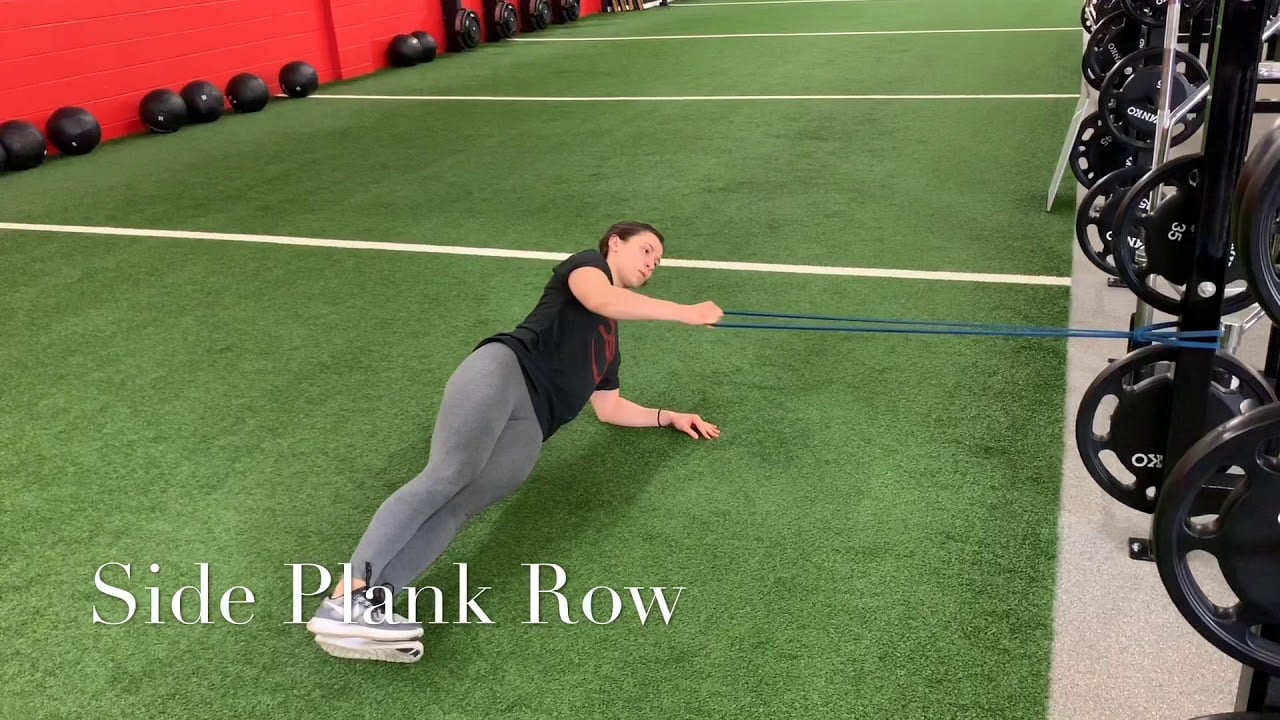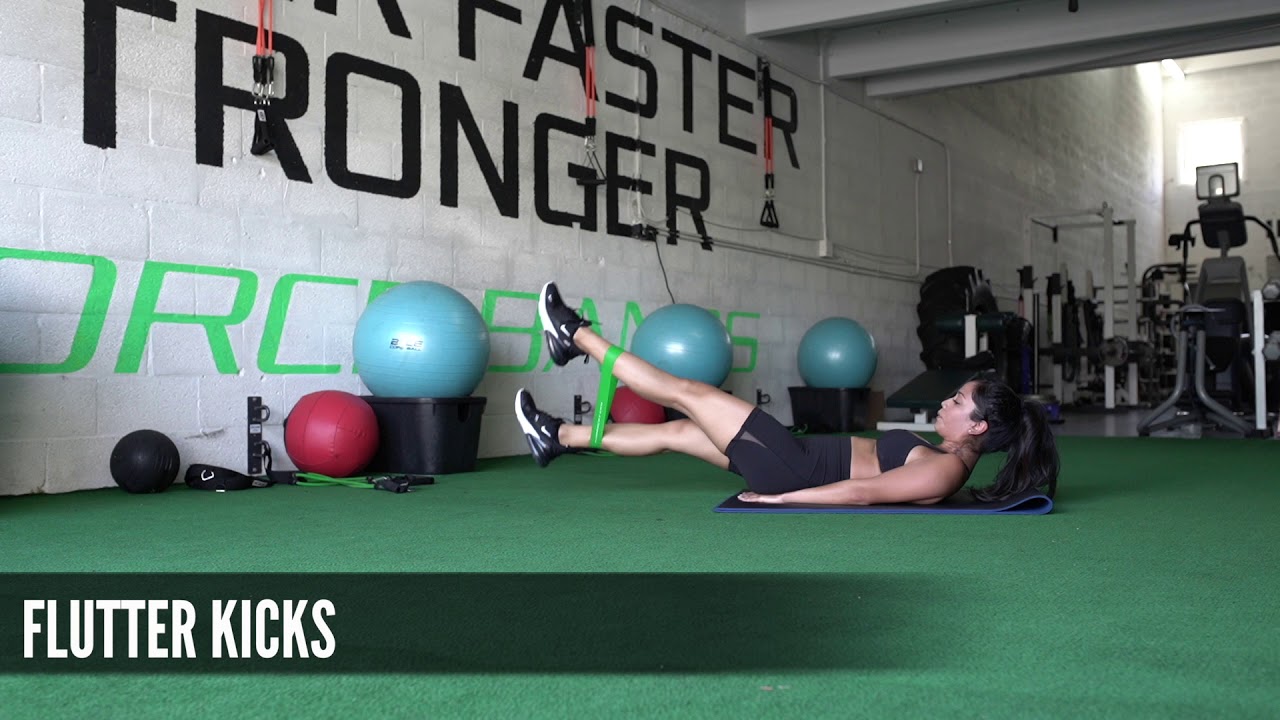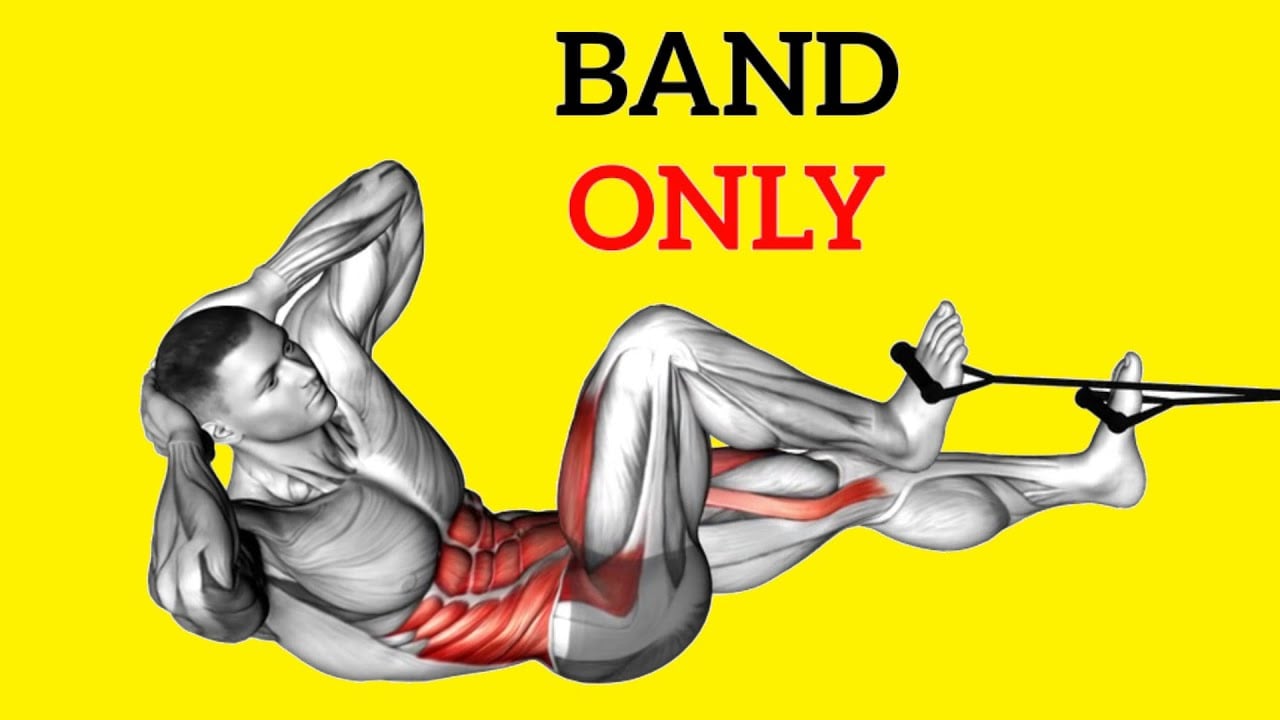You don’t need fancy gym equipment or $200/month memberships. A simple resistance band can deliver better results than most ab machines.
I know what you’re thinking: “Really? A $10 rubber band is going to give me a six-pack?”
Well, a 2019 study found that resistance band training was just as effective as traditional weight training for core strength gains. In fact, the constant tension from bands can activate up to 173% more muscle fibres compared to bodyweight exercises alone.
After testing 27 different resistance band ab exercises (and nearly snapping myself in half), I’ve narrowed it down to the 10 most effective moves that actually work.
Plus, I’ll give you a science-backed workout plan to put it all together.
So, let’s dive in.
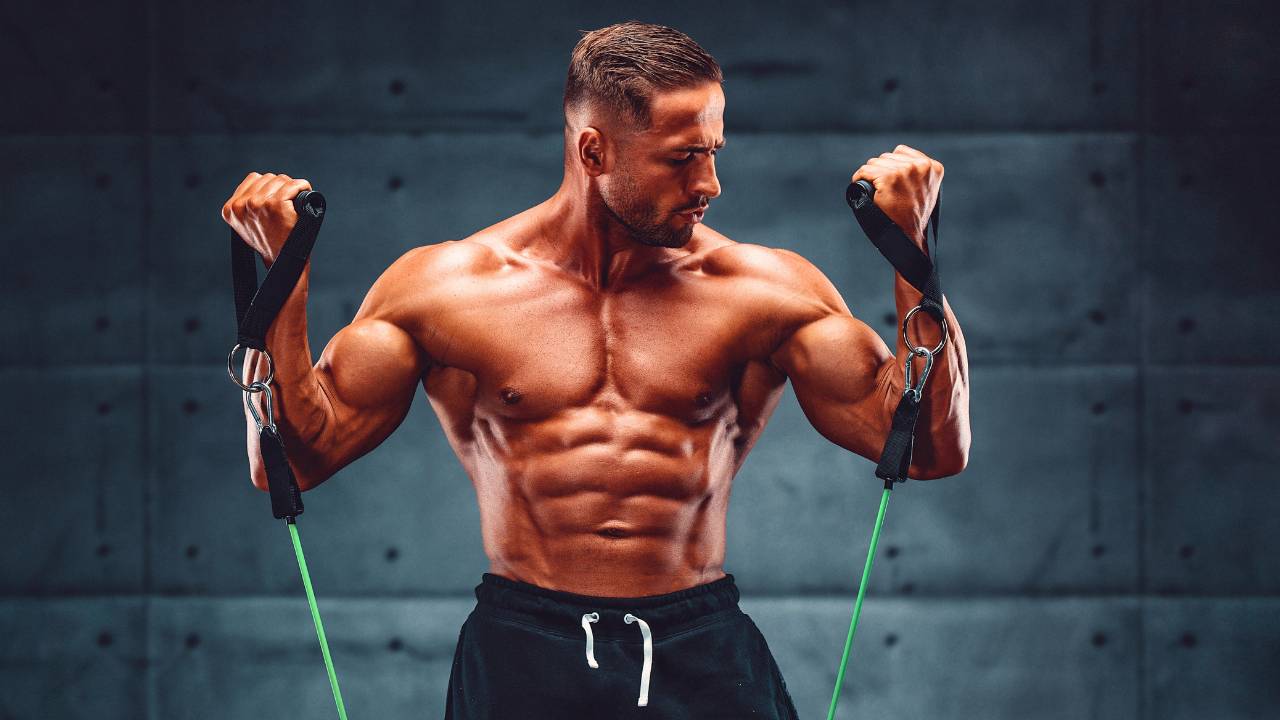
- Anatomy of Abs
- Abs
- Oblique
- 10 Best Abs Exercises With Resistance Band
- 1. Resistance Band Standing Crunch
- 2. Band Bicycle Crunch
- 3. Resistance Band Russian Twist
- 4. Band Reverse Crunch
- 5. Resistance Band Oblique Twist
- 6. Side Plank With Band Row
- 7. Resistance Band Pallof Press
- 8. Resistance Band Flutter kick
- 9. Resistance Band Side Bend
- 10. Resistance Band Wood Chopper
- Beginner Resistance Band Abs Workout Plan
- Band Oblique Workout Plan
- FAQs
- Standing ab exercises with resistance bands?
- Is Resistance training good for abs?
- More Resistance Band Exercises
- References
Anatomy of Abs
To build impressive six-pack abs, we first need to understand their anatomy and functionality, which helps us perform the cable abs exercises at the best level.
Your waist comprises two muscle groups: the rectus abdominis (known as your “six-pack” muscles) in the front and the obliques on each side.
Abs
When most of us refer to our abs, we usually represent the rectus abdominis (“abdominal muscle”).
The Rectus abdominis muscle arises from the lower margin of the rib cage and sternum and passes vertically downward to attach to the pubic bone.
Oblique
- The external oblique is the outer visible layer that runs diagonally on each side of the rectus abdominis. It is located between the lower rib region and the pelvis.
- The internal oblique muscles lie under the external obliques and run into the lower back or erector spinae.
The deepest part of the abdominals is the transversus abdominis, which lies horizontally across the abdominal wall.

Use our free calculator to know your weight loss calories requirement.
10 Best Abs Exercises With Resistance Band
Resistance bands make ab workouts harder and make the core muscles stronger and more defined. The bands elasticity keeps your abs, obliques, and midsection in a unique way.
You can strengthen all areas of your midsection with the added resistance of bands with these 10 exercises.
1. Resistance Band Standing Crunch
A study published in 2022 shows that resistance band training lowers body fat in overweight people better than other types of training, such as free weights and bodyweight exercises.
A resistance band crunch is a variation of the classic crunch exercise that targets the entire anterior core chain, from the deep transverse abdominis to the rectus abdominis (the “six-pack” muscles).
But here’s where it gets interesting: the constant tension from the band forces your core to work overtime, stabilizing your spine.
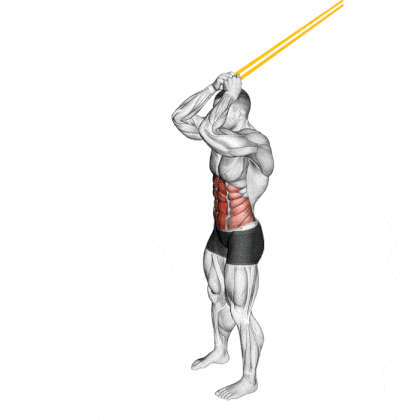
How To Do
- Use a door anchor or a cross-beam to secure the band to a high point above your head.
- Grab the band with both hands and place your hands on top of your head. Avoid pulling on neck
- Your feet should be shoulder width apart, and you should slightly unlock your knees for stability.
- Bend forward and bring your elbows in an arc towards your knees. To round your back, tuck your chin and flex your spine.
- As you crunch down, focus on using your abs muscles and squeeze at the bottom of the exercise. Exhale on the upward motion, inhale on return
- Return to the starting position and do the desired number of reps.
2. Band Bicycle Crunch
In a 2001 study by ACE, it was found that in compared to the standard crunch, the bicycle crunch produces 148% more mean activity in the abs and 190% more mean activity in the obliques.
The band Bicycle Crunch is essentially an ab-sculpting triple threat. First, it hammers your upper abs through the crunching motion. Then, it fires up your obliques (side abs) as you rotate. Finally, it engages your lower abs through the leg movement pattern.
Band bicycle crunches work more core muscles than regular bicycle crunches. This is because you must work harder to stabilise the resistance band.
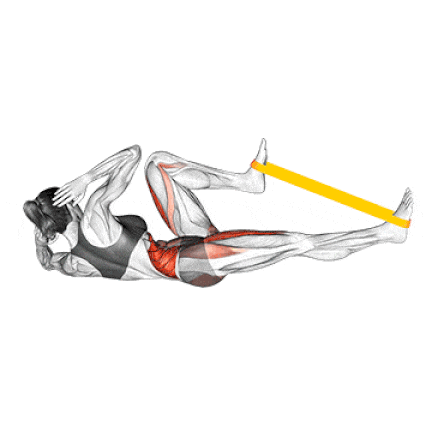
How To Do
- Lie back and loop the band around both feet, creating tension by positioning yourself at an appropriate distance
- Position your hands gently behind your head, keeping your neck neutral (pro tip: imagine holding an egg between your chin and chest)
- Lift your shoulder blades off the ground and bring both knees up to tabletop position (thighs perpendicular to the floor)
- Extend your right leg fully against the band resistance and simultaneously rotate your torso, bringing your left elbow towards your right knee. Your extended leg should stay a few inches off the ground.
- Smoothly switch sides and pull your right leg back in while extending your left. Rotate your torso the opposite way, from the right elbow to the left knee.
- Continue this fluid, cycling motion while maintaining constant tension in the band.
- Start with 3 sets of 30 seconds, building up to 45-60 seconds as you get stronger.
3. Resistance Band Russian Twist
The Russian twist is a great way to do abs exercises at home; it engages your core and strengthens your abdominal and lower back muscles.
Russian twists and rotational movement effectively engage multiple muscle groups, primarily the obliques, rectus abdominis, and transverse abdominis.
Moreover, banded Russian twists can be easily modified to suit your fitness levels.
- Beginners can perform them with their feet on the ground or use lighter bands,
- While advanced practitioners can lift their feet off the ground or increase resistance by moving further away from the anchor point.
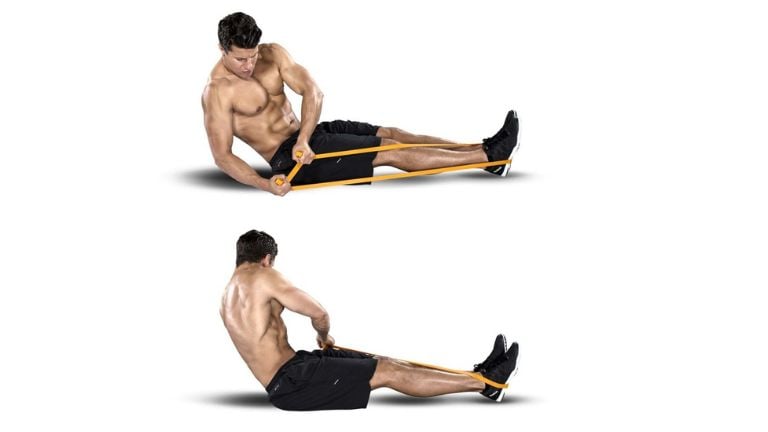
How To Do
- Sit on the ground with your knees bent and your feet planted on the floor.
- Place the resistance band around your feet and hold the handles with your hands.
- Recline your torso to a 45-degree angle; think about making a ‘V’ shape with your body.
- Turn your body to the right and bring your hands to your right hip.
- Return to the centre before twisting to the left.
- Move deliberately from side to side with control.
4. Band Reverse Crunch
Traditional reverse crunches are great. But adding resistance bands takes them to a whole new level.
Banded reverse crunches primarily target the rectus abdominis and obliques, but they also engage the hip flexors and lower back muscles.
In fact, this is the same exercise variation that helped one of my clients increase their core strength by 43% in just 8 weeks.
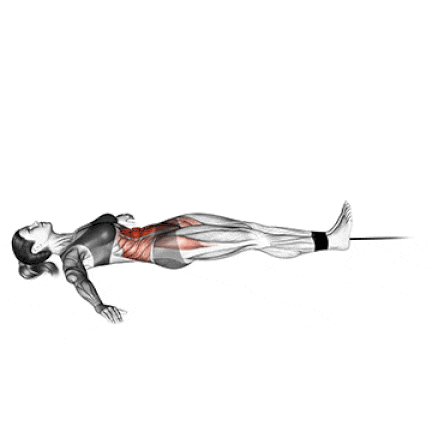
How To Do
- Loop the resistance band securely around a sturdy anchor point.
- Place the other end around both feet/ankles. Ensure the band has no twists and sits comfortably.
- Lie flat on your back on a mat or floor. Keep your lower back pressed against the ground.
- Bend your knees at approximately 90 degrees and place your arms flat on the floor, palms down.
- Engage your core by drawing your navel toward your spine and slowly lift your hips and glutes off the floor
- Lift your hips up and bring your knees towards your chest. At the top, your knees should be over your chest.
- Slowly lower your legs back to the starting position. Control the descent.
5. Resistance Band Oblique Twist
The standing oblique twist is one of the best exercises for targeting your core muscles. It is also one of the few exercises that specifically targets the side muscles of your abs, also known as “obliques.”
You don’t need a lot of space to move. Try the exercises below at home, in your hotel room, or at the gym—no lying on dirty floors required.
Start with a band that offers light to moderate resistance.
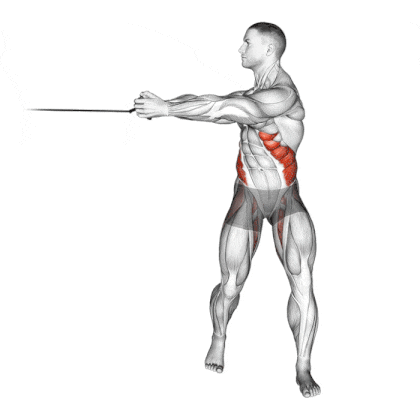
How To Do
- Attach a resistance band to a stable object at waist height. Make sure it’s secure.
- Stand about a foot away from the anchor point, facing sideways. Grab the band handles with both hands, arms fully extended in front of you and directly at chest level.
- Pull the band across your body by rotating your torso. As you twist, focus on using your obliques to drive the movement, not your arms.
- Hold for a count of two at the end of the twist to maximize the tension. Slowly return to the starting position, keeping control of the movement.
- Do 10–12 reps on each side for 2–3 sets.
6. Side Plank With Band Row
The Side Plank With Band Row is a dynamic exercise that combines the stability of the side plank with the strength-building benefits of a rowing motion
BUT unlike bare planks, you’re fighting rotation AND lateral forces simultaneously.
Research shows that combining isometric holds (like the side plank) with dynamic movements (like the row) lead to greater muscle activation. This means users can achieve more significant strength gains in less time.
How To Do
- Lie on your side with your legs straight and your feet stacked on top of each other.
- Use resistance to attach a handle to the low pulley.
- Brace your core and do a side plank on your right side.
- Keep your hips pushed up and forward as you pull the band to your rib cage.
- Slowly straighten your arm back in front of you.
- Complete all reps on your left side, then switch to your right side, grab the handle with your left hand, and repeat.
7. Resistance Band Pallof Press
The resistance band Pallof press is an anti-rotation core exercise that targets the obliques and transverse abdominis.
There are a number of variations of the resistance band Pallof press that you can try, such as:
- Kneeling Pallof press: To make the exercise easier, you can kneel on one knee.
- Pallof press with rotation: To add more challenge to the exercise, you can rotate your torso slightly as you press the resistance band away from you.
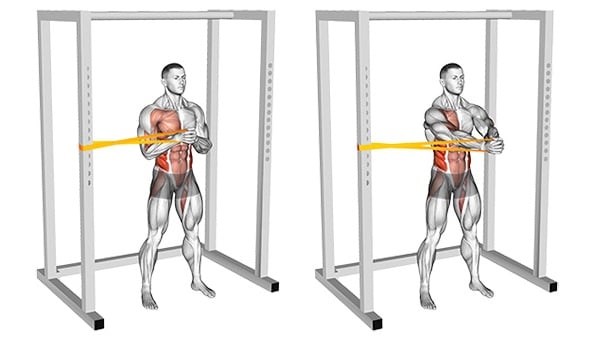
How To Do
- Anchor the resistance band to chest height and stand in a split stance.
- Engage your core muscles and use both hands to push the handle out, so your arms are in front of your chest.
- Hold this position for five to ten seconds and then bring the handle back to your chest. Don’t let your torso rotate.
- Repeat the exercise on your opposite side.
8. Resistance Band Flutter kick
Flutter kicks are an exercise that targets the lower abs, plus the hip flexors.
You can do the traditional flutter kick without any equipment, but you can improve it by using resistance bands.
Beginners can start with basic flutter kicks without the band and gradually add the band for increased resistance.
How To Do
- Lie flat on your back on a mat with a resistance band looped around the arches of your feet.
- Place your hands under your buttocks or by your sides for support, and lift your legs slightly off the ground.
- Keep your legs as low as you can while maintaining good form.
- Start to kick your legs up and down in a small, rapid motion.
- Continue fluttering for a set time period or for a specific number of repetitions.
9. Resistance Band Side Bend
If you’re looking for an oblique exercise to include in your band workout plan, practice side bends.
Band side bend is an isolation exercises that targets muscle groups on the side of your body—specifically the oblique muscles.
Training the oblique muscles will help in shaping and toning the waistline. It also helps to get rid of the extra layer of fat around the waistline.

How To Do
- Stand with your feet shoulder-width apart, and secure one end of the resistance band under your feet or attached with the door.
- Hold the other end of the band with one hand.
- Bend your torso to the side opposite the hand holding the band.
- Slowly return to the upright position.
- After completing a set on one side, switch the band to the other hand and repeat the exercise for the other set of obliques.
- Aim for 10-15 bends per side for 2-3 sets.
10. Resistance Band Wood Chopper
The wood chop is also known as the up-down twist. You can use easily incorporate band wood chop exercises into your routine to build strength in your core muscles including low back, abs, oblique and hip muscles.
Other Variations
- Kneeling band wood chop: To make the exercise easier, you can kneel on one knee.
- Reverse band wood chop: pulling the band in a diagonally upward motion.
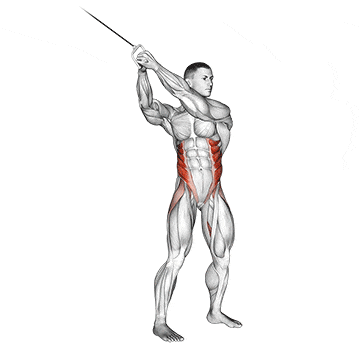
How To Do
- Secure the resistance band at a high point, such as around a sturdy pole or in a door jamb.
- Stand sideways to the band’s anchor point with your feet shoulder-width apart.
- Grab one end of the band with both hands and extend your arms straight out in front of your body.
- Don’t lock the knees and hips. Allow the hips and knees to rotate slightly.
- Move your arms down and across your body so that your hands are outside your opposite hip.
- Pause at the bottom of the movement, then slowly rotate your torso back to the starting position.
- Repeat for 10-12 repetitions, then switch sides.
Beginner Resistance Band Abs Workout Plan
| Exercise | Sets | Reps |
|---|---|---|
| Band Cable Crunch | 3 | 10-15 |
| Band Reverse Crunch | 3 | 10-15 |
| Pallof Press | 3 | 8-12 |
| Band Side Bend | 2 | 10-12 |
Band Oblique Workout Plan
| Exercise | Sets | Reps |
|---|---|---|
| Band Side Bend | 3 | 10-15 |
| Band Russian Twist | 3 | 8-10 |
| Cable Wood Chop | 3 | 8-12 |
| Standing Oblique Crunches | 2 | 10-15 |
FAQs
Standing ab exercises with resistance bands?
- Standing Oblique Twists
- Standing Pallof Press
- Standing Resistance Band Crunches
- Standing Side Bends
- Standing Wood Chops
- Resistance Band High Pulls
- Standing Russian Twists
- Resistance Band Twist and Reach
- Overhead Resistance Band Stretch
- Standing T-Abs Twist
Is Resistance training good for abs?
Yes, resistance training is good for abs. It helps strengthen and define abdominal muscles more effectively than exercises without resistance.
More Resistance Band Exercises
- Best Resistance Band Chest Exercises
- Resistance Band Back Workouts
- Best Resistance Band Shoulder Exercises
- Resistance Band Trap Exercises
- Best Resistance Band Tricep Exercises
References
- Santos, J., Aryane Flauzino Machado, Jéssica Kirsch Micheletti, Castilho, A., Priscilla and Carlos Marcelo Pastre (2019). Effects of training with elastic resistance versus conventional resistance on muscular strength: A systematic review and meta-analysis.
- Örgün E, Kurt C, Özsu İ. The effect of static and dynamic core exercises on dynamic balance, spinal stability, and hip mobility in female office workers. Turk J Phys Med Rehabil. 2019 Dec 25;66(3):271-280. doi: 10.5606/tftrd.2020.4317. PMID: 33089083; PMCID: PMC7557618.
- Vera-Garcia FJ, Grenier SG, McGill SM. Abdominal muscle response during curl-ups on both stable and labile surfaces. Phys Ther. 2000 Jun;80(6):564-9. PMID: 10842409.
- Fransfile Manihuruk, Sumaryanto, Sigit Nugroho and Setyawan Widyarto (2023). the Effect of Exercise Using Resistance Bands on Improving the Balance of Badminton Athletes.

Manish is a NASM-certified fitness and nutrition coach with over 10 years of experience in weight lifting and fat loss fitness coaching. He specializes in gym-based training and has a lot of knowledge about exercise, lifting technique, biomechanics, and more.
Through “Fit Life Regime,” he generously shares the insights he’s gained over a decade in the field. His goal is to equip others with the knowledge to start their own fitness journey.

